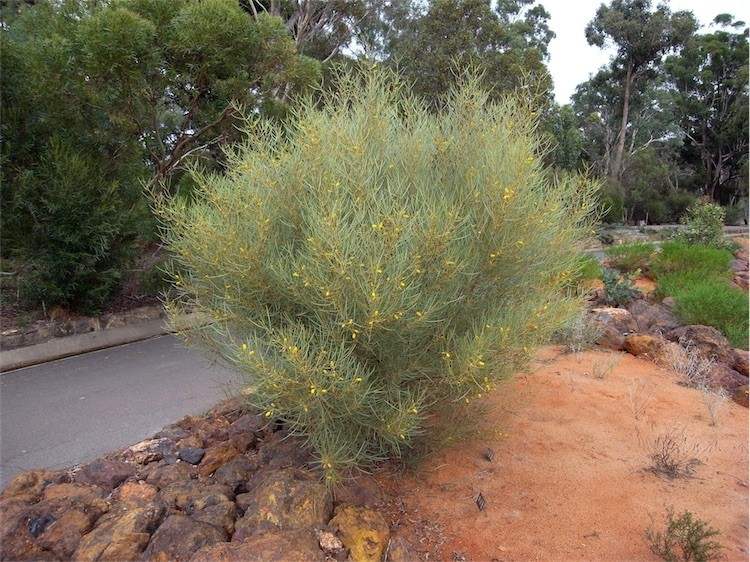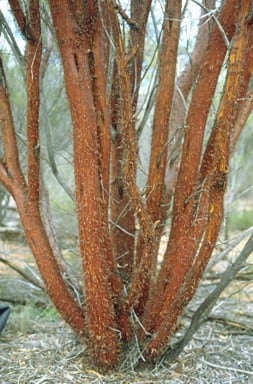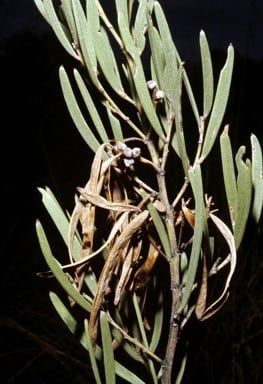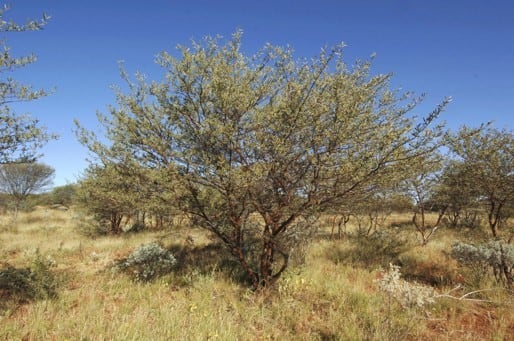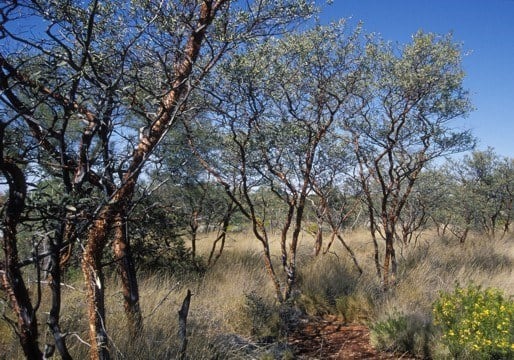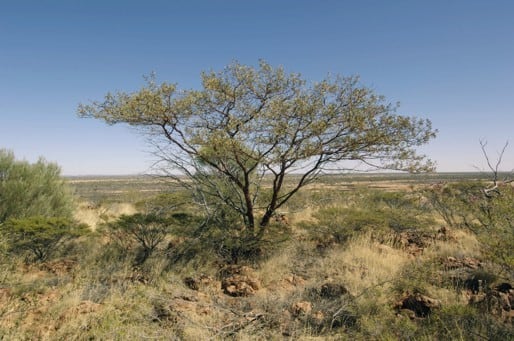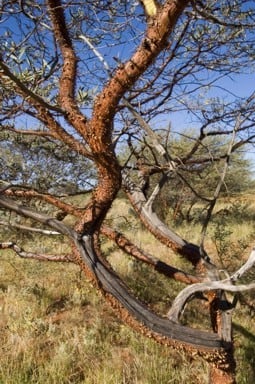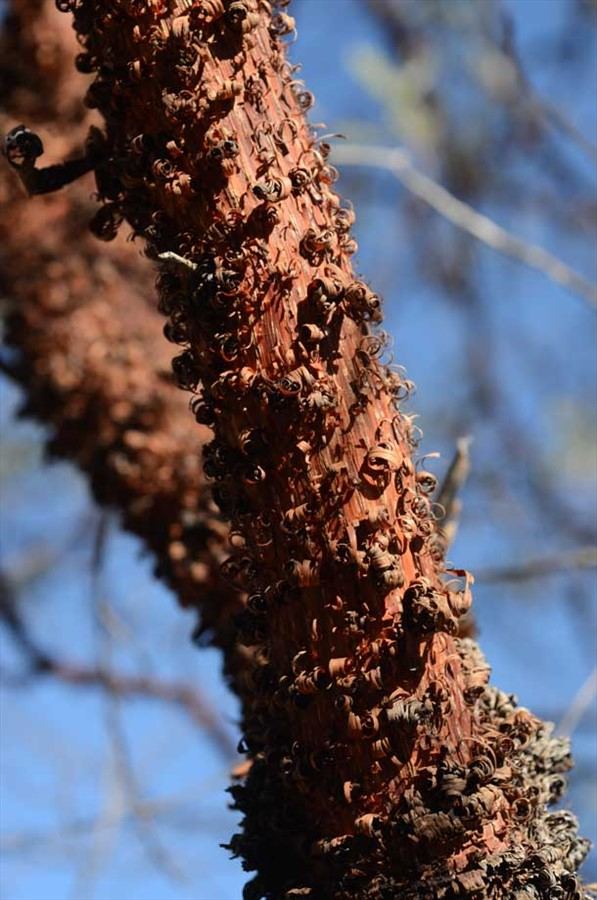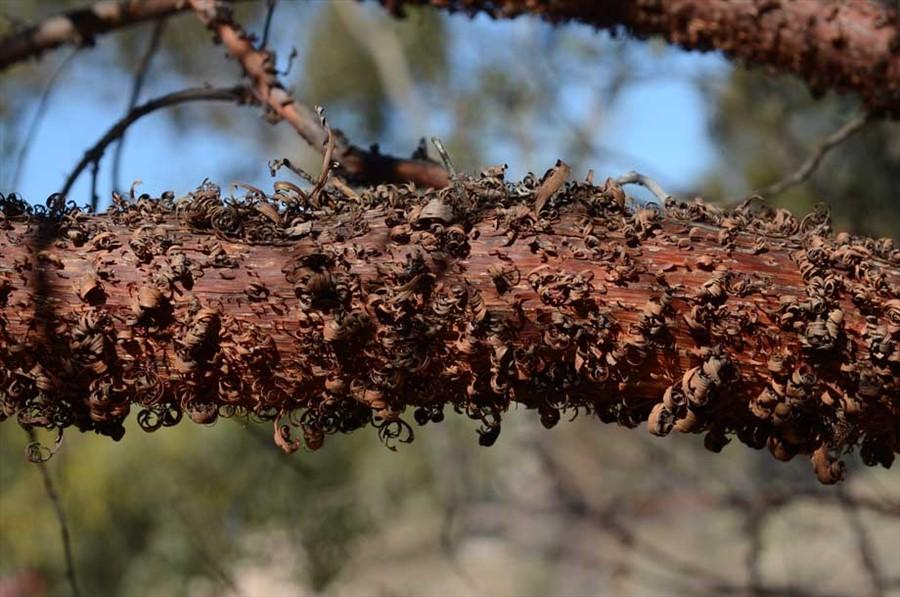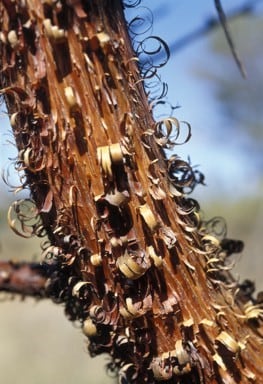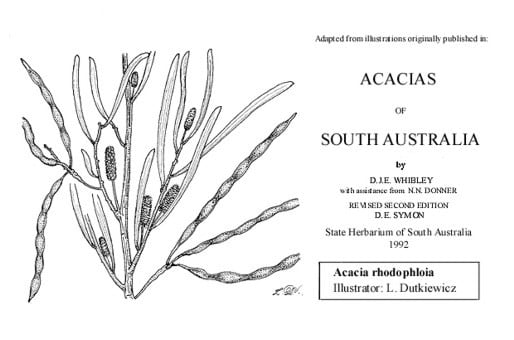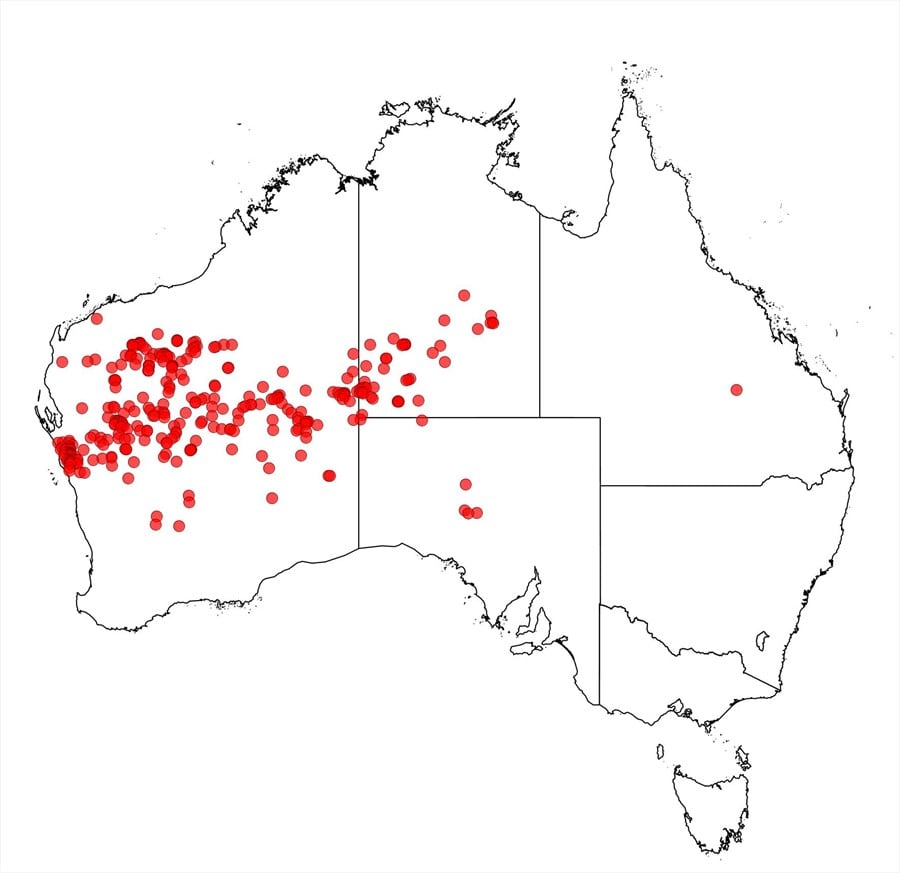Acacia rhodophloia Maslin
WATTLE
Acacias of Australia
Common Name
Western Red Mulga, Minni Ritchi
Family
Fabaceae
Distribution
Occurs in arid subtropical Australia from the Pilbara–Murchison regions, W.A., E to the Ehrenberg Ra. and S to Bloods Ra. and Docker Ck area, N.T., with a record N of Tarcoola in S.A.; mainly in a zone between 23ºS to 29ºS.
Description
Shrub or tree 1.5–4 (–6) m high, upper branches often ±horizontally spreading. Bark ‘Minni Ritchi’, red or maroon. Branchlets glabrous or with an inconspicuous indumentum obscured by dry resin at the sometimes angled extremities. Phyllodes narrowly elliptic to narrowly oblong-elliptic, infrequently linear or oblong-oblanceolate, (2–) 3–7 (–10) cm long, (2–) 4–10 (–13) mm wide, straight to shallowly falcate, innocuous to coarsely pungent, ±rigid, coriaceous, glabrous or sparsely and obscurely appressed-hairy between the nerves, dull green to grey-green; finely multistriate with the nonanastomosing nerves of uniform prominence or central one slightly pronounced, 8–10 per mm; gland 1, ±obscure, basal. Inflorescences simple; heads ±globular to cylindrical spikes, 6–25 mm long, normally about as long as peduncles, densely flowered; peduncles 5–20 mm long. Flowers mostly 5-merous; calyx gamosepalous, dissected to 1/6–1/3, slightly longer than half length of petals. Pods linear, ±flat, 1.5–9 cm long, 2–6 (–7) mm wide, thinly crustaceous, flat. Seeds ±longitudinal, oblong-elliptic, 2–4.5 mm long, arillate.
Phenology
Flowers sporadically especially Mar.–Oct.
Habitat
Grows in drier areas, in red sandy soils or on rocky ground, often on laterite, quartzite or granite, in gullies along creeks, on plains, sand hills, mesas or scree slopes, in scrub heath, Casuarina scrub or frequently associated with spinifex.
Specimens
W.A.: Maroonbah, J.S.Beard 6178 (NSW); Winduldurra Rock Hole, 51 miles [81.6 km] SW [of ]Warburton Mission, H.Martin (NSW, UNSW3560G); Gibson Desert, 71 km S by road from Warburton on road to Rawlinna, B.R.Maslin 5678 (NSW, PERTH); 14.4 miles [23.2 km] N of the bridge over the Murchison R. on NW Coastal Hwy, M.D.Tindale 2738 (NSW, PERTH); 16 miles [25.6 km] S of Murchison R. bridge, M.D.Tindale 1323 (BRI, CANB, K, NSW, PERTH, US). N.T.: Bloods Ra., J.R.Maconochie 1400 (DNA, NSW, PERTH); 16 km East Docker R., J.R.Maconochie 1850 (AD, BRI, DNA, K, PERTH). S.A.: Mulgathing–Bulgunnia Stn fence, B.Lay 768 (AD).
Notes
Belongs to a taxonomically complex small group of species including A. adsurgens, A. atkinsiana, A. kempeana and A. sibirica. Distinguished from all these species by its red ‘Minni Ritchi’ bark. Also related to A. cyperophylla, A. desmondii and A. leeuweniana. Very close to A. doreta with which it possibly sometimes hybridizes. Possible hybrids also occur between A. rhodophloia and both A. adsurgens (see A. adsurgens × rhodophloia) and A. sibirica (see A. rhodophloia × sibirica).
Acacia rhodophloia is a variable species in need of critical revision. The two Tindale specimens from the type area (Murchison R.) are characterised by phyllodes 3–8 mm wide, pods c. 2 mm wide, and inflorescences ±round to broadly ellipsoidal. B.R.Maslin, J. Adelaide Bot. Gard. 2: 318–319 (1980), stated that there are other recognisable forms. From Central Australian desert areas there is a form with narrower phyllodes (2–4 mm wide), broader pods (3–6 mm wide) and spicate inflorescences (e.g. H.Martin UNSW3560G and Maslin 5678). He also recorded a variant from the Pilbara region, W.A., with smaller, fimbriate, nerveless calyces and interrupted spikes (e.g. Beard 6178); this variant, which is now described as A. leeuweniana, is related to A. cyperophylla. Another variant is discussed by B.R.Maslin, Nuytsia 4: 98 (1982), from the Hamersley Ra., W.A., with narrowly elliptic (instead of linear) phyllodes 4.5–6.5 cm long and 5–8 mm wide.
Acacia rhodophloia is killed by hot fire and regenerates from seed. Indigenous people of the Pilbara used the extremely hard wood for spears and wooden tools.
FOA Reference
Data derived from Flora of Australia Volumes 11A (2001), 11B (2001) and 12 (1998), products of ABRS, ©Commonwealth of Australia
Author
Revised by B.R.Maslin
Dr M.D.Tindale and Dr P.G.Kodela with the assistance of M.Bedward, S.J.Davies, C.Herscovitch, D.A.Keith and/or D.A.Morrison
This identification key and fact sheets are available as a mobile application:
URL: https://apps.lucidcentral.org/wattle/
© Copyright 2018. All rights reserved.
